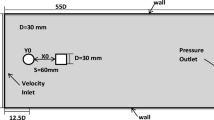Abstract
In process industries Coriolis mass flow meters (CMFs) are widely employed for measuring mass flows. Quite often, especially in the oil and gas (O&G) industry, owing to fluids with high viscosities, flow measurements may lie in low Reynolds number regions. At low Reynolds numbers (Re), a CMF reading may deviate under the influence of fluid-dynamic forces. With the help of extensive Fluid-Structure-Interaction simulations (FSI), a detailed insight into physical mechanisms leading to this deviation is provided. The main finding is that this deviation is a function of the Reynolds number and the effect can be explained by a periodic shear mechanism which interacts with the oscillatory Coriolis force and reduces the tube deflection. Experimental results with and without a correction for this effect are shown and compared with corresponding numerical results. If the low Reynolds number effect were ignored, it would lead to errors as large as 0.5% to 1% at Re = 800, however by measuring the Re and making corrections, the effect is reduced to < 0.2%.
Similar content being viewed by others
References
V. Kumar, M. Anklin and B. Schwenter, Fluid-Structure Interaction (FSI) Simulations on the Sensitivity of Coriolis FlowMeter Under Low Reynolds Number Flows, 15th Flow Measurement Conference FLOMEKO, Taipei Taiwan, (2010).
J. Kutin, J. Hemp, G. Bobovnik and I. Bajsić, Weight Vector Study of Velocity Profile Effects in Straight-Tube Coriolis Flow Meters Employing Different Circumferential Modes, Flow Measurement and Instrumentation, 16 (2005) 375–385.
G. Bobovnik, N. Mole, J. Kutin, B. Stok and I. Bajsi, Coupled Finite-Volume/Finite Element Modeling of the Straight-Tube Coriolis Flow Meter, Journal of Fluid and Structures, 20 (2005) 785–800.
J. Kutin, G. Bobovnik, J. Hemp and I. Bajsi, Velocity Profile Effects in Coriolis Mass Flow Meters: Recent Findings and Open Questions, Flow Measurement and Instrumentation, 17 (2006) 349–358.
O. Reynolds, On the Dynamical Theory of Incompressible Viscous Fluids and Determination of the Criterion, Philos. Trans. of R. Soc. London, Ser. A-186 (1895)123–164.
H. Schlichting and K. Gersten, Boundary Layer Theory, 8th Edition, Springer-Verlag, (2000).
V. Kumar, P. Tschabold and M. Anklin, Influence and Compensation of Process Parameters on Coriolis Meters with a View to Custody Transfer of Hydrocarbon Products, NEL 9th South East Asia Hydrocarbon Flow Measurement Workshop, (2010).
A. Rieder, Coriolis Mass Flow Meter with Direct Viscosity Measurement, Pumps and Compressors with Compressed Air and Vacuum Technology, (2010) 52–55.
Author information
Authors and Affiliations
Corresponding author
Rights and permissions
About this article
Cite this article
Kumar, V., Anklin, M. Numerical simulations of Coriolis flow meters for low Reynolds number flows. MAPAN 26, 225–235 (2011). https://doi.org/10.1007/s12647-011-0021-6
Received:
Revised:
Accepted:
Published:
Issue Date:
DOI: https://doi.org/10.1007/s12647-011-0021-6




